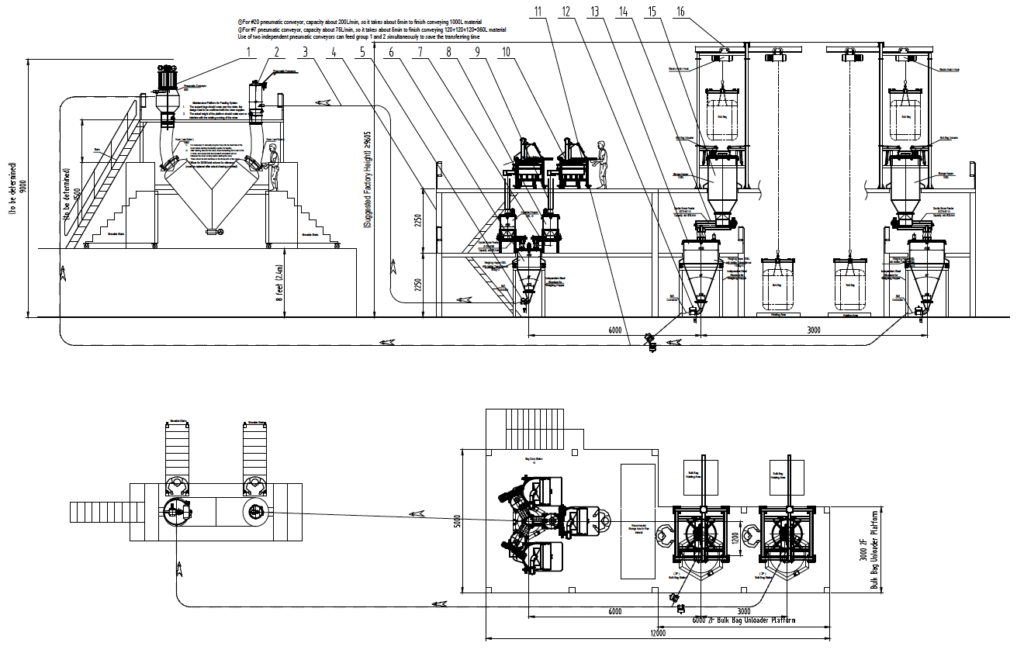
The Difference In Loss-In-Weight Feeders And Gain-In-Weight Feeders And Which One Is Right For Your Mixing Application
Loss-in-weight feeders and gain-in-weight feeders are both types of gravimetric feeders used in industrial processes, particularly in applications where precise control over material flow is crucial, such as mixing applications. Let’s explore the differences between these two types of feeders and consider which one might be suitable for your mixing application.
- Loss-in-Weight Feeders:
- Principle: Loss-in-weight feeders operate on the principle of continuously weighing the material as it is being fed into the process. The feeder starts with a known amount of material in a hopper, and as material is discharged, the decrease in weight is continuously monitored.
- Application: Loss-in-weight feeders are suitable for applications where precise control of material flow and accurate dosing is critical. These feeders are often used in processes where the material flow rate needs to be precisely controlled and adjusted based on real-time weight measurements.
- Advantages:
- High accuracy in feeding materials.
- Precise control of material flow.
- Suitable for applications with varying material densities.
- Gain-in-Weight Feeders:
- Principle: Gain-in-weight feeders work by continuously adding material to a container or vessel on a weighing system. The system monitors the weight gain, and once the desired weight is reached, the feeding mechanism is stopped.
- Application: Gain-in-weight feeders are commonly used in applications where a predetermined amount of material needs to be added to a process. They are suitable for batch processes where a specific quantity of material is required for each batch.
- Advantages:
- Well-suited for batch processes.
- Ideal for applications where a specific amount of material needs to be added.
Choosing the Right Feeder for Your Mixing Application:
- Continuous vs. Batch Processing: If your mixing process is continuous and requires precise control of material flow rates, a loss-in-weight feeder may be more suitable. If your process operates in batches and requires the addition of a specific amount of material for each batch, a gain-in-weight feeder may be a better choice.
- Material Characteristics: Consider the characteristics of the materials you are working with. Some materials may be better suited for one type of feeder over the other, depending on factors like flowability and consistency.
- Accuracy Requirements: If your application demands high precision in material dosing and continuous adjustment based on real-time weight measurements, a loss-in-weight feeder may be more appropriate.
Ultimately, the choice between loss-in-weight and gain-in-weight feeders depends on the specific requirements of your mixing application and the characteristics of the materials involved. Consulting with a specialist in industrial feeding systems can help you determine the most suitable option for your needs.
Mixing & Matching Loss-in-Weight for Minor Ingredients & Gain-in-Weight for Major Ingredients
Mixing and matching loss-in-weight (LIW) feeders for minor ingredients and gain-in-weight (GIW) feeders for major ingredients can be a practical approach in certain mixing applications. This strategy leverages the strengths of each feeder type based on the specific requirements of the ingredients and the overall process. Here’s how you can implement this combination:
- Loss-in-Weight Feeders for Minor Ingredients:
- Use loss-in-weight feeders for minor ingredients that require precise control and accurate dosing.
- Minor ingredients are often added in smaller quantities, and the continuous monitoring and adjustment provided by loss-in-weight feeders can ensure tight control over the material flow.
- Gain-in-Weight Feeders for Major Ingredients:
- Employ gain-in-weight feeders for major ingredients that are added in larger quantities during batch processes.
- Gain-in-weight feeders are well-suited for applications where a specific amount of material needs to be added for each batch, providing efficient and accurate batch dosing.
- Benefits of Mixing and Matching:
- Accuracy and Precision: This approach allows you to achieve high accuracy and precision for minor ingredients while efficiently handling the bulk dosing requirements of major ingredients.
- Flexibility: The flexibility to choose the most suitable feeder type for each ingredient based on its characteristics and the desired level of control.
- Optimized Process: By tailoring the feeding technology to the specific needs of each ingredient, you can optimize the overall mixing process.
- Considerations:
- Integration and Communication: Ensure that the loss-in-weight and gain-in-weight feeders can be integrated into your control system and communicate effectively. This is crucial for coordinating the feeding of both minor and major ingredients seamlessly.
- Material Characteristics: Consider the characteristics of each ingredient, such as flowability and consistency, when selecting the appropriate feeder type.
- System Calibration: Regular calibration and maintenance of both types of feeders are essential to ensure their accuracy and reliability over time.
By carefully assessing the characteristics of your ingredients, the specific requirements of your mixing process, and the capabilities of loss-in-weight and gain-in-weight feeders, you can design a feeding system that optimally meets your application’s needs. Consulting with experts in industrial feeding systems can provide valuable insights and assistance in implementing this mixed approach effectively.





